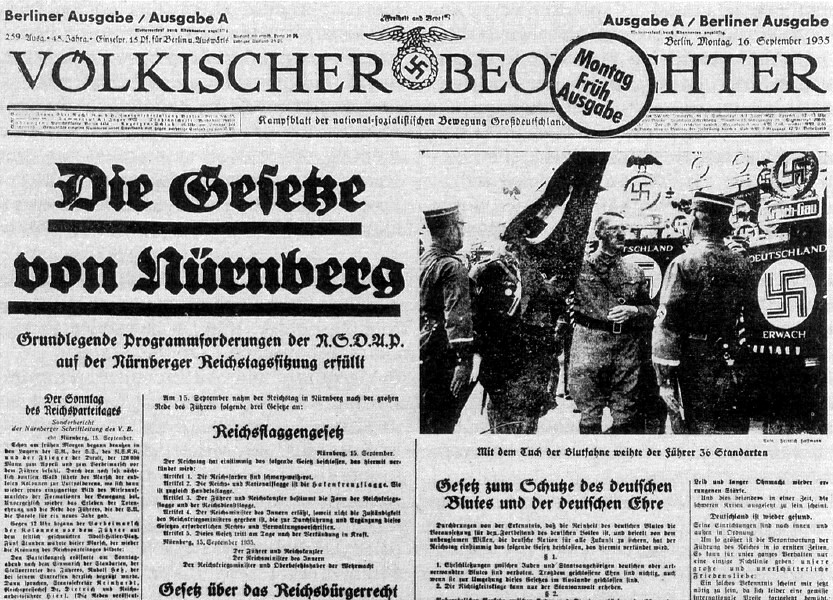Holocaust Education & Archive Research Team |
|
Holocaust Prelude Early Nazi Leaders Nazi Propaganda Nazi Racial Laws Sinti & Roma Kristallnacht The SS SS Leadership Wannsee
Prelude Articles Image Galleries | ||
The Nürnberg Laws
In 1933, although less than 1% of the German population was Jewish. Jews contributed significantly to German culture. Many served in World War I and thought of themselves as Germans first and Jews second. They considered Germany a home; their passionate ties and blind loyalty to Germany caused them to be blind to the harsh reality of anti-Semitic measures The Nürnberg Laws were the first attempt by the Nazi government to define the Jews and as such, play a pivotal role in the process that lead to their annihilation.
A conference of ministers was held on August 20, 1935, to discuss the economic effects of Party actions against Jews. Adolf Wagner, the Party representative at the conference, argued that such actions would cease, once the government decided on a firm policy against the Jews. Schacht made no moral condemnation of Jewish policy and advocated the passing of legislation to clarify the situation. The following month two measures were announced at the annual Party Rally in Nürnberg, becoming known as the Nürnberg Laws. Both measures were hastily improvised (there was even a shortage of drafting paper so that menu cards had to be used) and Jewish experts from the Ministry of the Interior were ordered to Nürnberg by plane. The first law, The Law for the Protection of German Blood and German Honor, prohibited marriages and extra-marital intercourse between “Jews” (the name was now officially used in place of “non-Aryans”) and “Germans” and also the employment of “German” females under forty-five in Jewish households. The second law, The Reich Citizenship Law, stripped Jews of their German citizenship and introduced a new distinction between “Reich citizens” and “nationals.” Hitler now had more direct control over the government and political attitude to Jews in Nazi Germany. In the period 1937 to 1938, harsh new laws were implemented, and the segregation of Jews from the German "Aryan" population began. In particular, Jews were punished financially for their "race." The increasingly totalitarian, militaristic regime that Hitler imposed on Germany allowed him to control the actions of the SS and the army. On November 7, 1938, a young Polish Jew named Herschel Grynszpan attacked and shot two German officials in the Nazi-German embassy in Paris over the treatment of his parents by the Nazi-Germans. Joseph Goebbels took the opportunity to impress Hitler, and ordered retaliation. On the night of November 9 the SS conducted the Night of Broken Glass ("Kristallnacht"), in which the storefronts of Jewish shops and offices were smashed and vandalized. Approximately 100 Jews were killed, and another 20,000 sent to concentration camps. Collectively, the Jews were made to pay back one billion RM in damages; the fine was collected by confiscating 20% of every Jew's property. Hitler in effect had made his policy of "The Third Reich" more effective for every nation he ruled.
Sources: The Holocaust Encyclopedia. Publications International LTD. Explaining Hitler by Ron Rosenbaum Harper Perrenial USMMM NARA
Copyright Carmelo Lisciotto H.E.A.R.T 2006-2007
|

